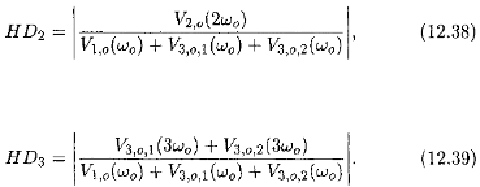Environmental Engineering Reference
In-Depth Information
The second-order harmonic component of the response of the peri-
odically switched nonlinear circuit is determined from the response
of the second-order Volterra circuit with the input at frequencies
and the output at the frequency
The third-order harmonic component of the response of the peri-
odically switched nonlinear circuit is obtained by summing up the
contribution of
with inputs
and
at frequencies
and the output at the frequency
The second-order harmonic distortion of the circuit is computed from
and the third-order harmonic distortion in obtained from
3.4 The Fold-Over Effect
Eqs.(12.32), (12.34) and (12.36) demonstrate that the high-order side
band components of the inputs of and contribute to both the
fundamental and harmonic components of the response in the base band.
This is analogous to the fold-over effect encountered in the noise analysis
of periodically switched linear circuits presented in Chapter 11. The
folding effect in computing is illustrated graphically in Fig. 12.1.
The frequency reversal theorem introduced in Chapter 3 can be employed
to reduce the cost of computation in calculating these aliasing transfer
functions.
4. Intermodulation Distortion
Intermodulation distortion arises when the input of a periodically
switched nonlinear circuit contains two or more sinusoidal signals of
different frequencies. For example, in a RF receiver, the frequency dif-
ference between two adjacent channels at frequencies
and
denoted
















Search WWH ::

Custom Search